The Back of Greek Beyond: Anafi
“Prospective visitors wanting a tantalizing preview of Anafi—without braving the 16-hour ferry journey from Piraeus—will find it without leaving Athens. On the steep northern slopes of the capital’s Acropolis is the tiny urban neighborhood of Anafiotica, a maze of twisting streets, flights of narrow steps, and whitewashed houses piled one atop the other, all reminiscent of Anafi’s capital, Chora. In the 1830s, Anafi’s skilled craftsmen came to Athens to build King Otho’s new palace and recreated their island home in the shadow of the Parthenon.”—Michael House
Polemicist on Holiday
By Michael House, FRGS
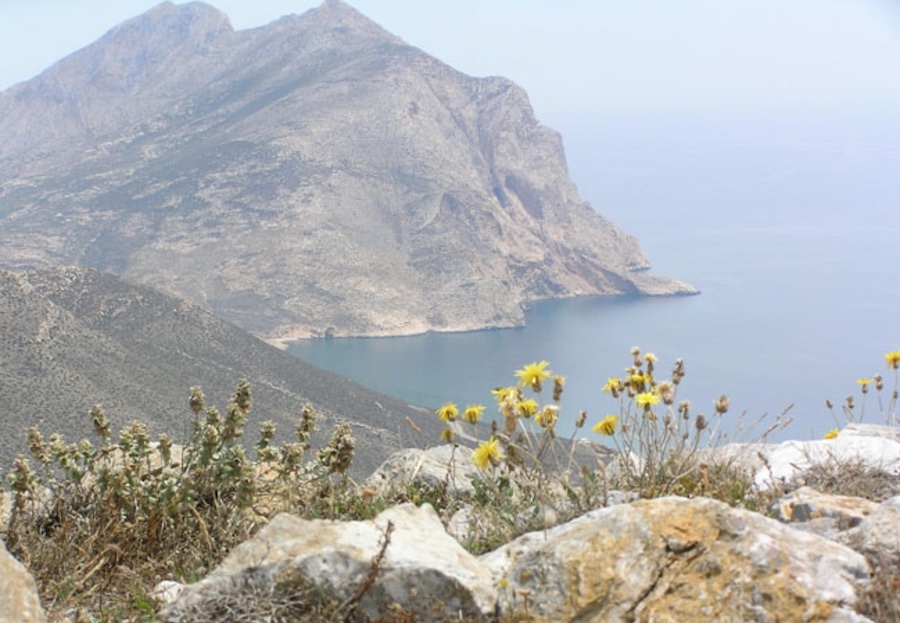
“We are inundated with advice on where to travel to, but we hear little of why and how we should go, even though the art of travel seems naturally to sustain a number of questions neither so simple nor so trivial, and whose study might in modest ways contribute to an understanding of what the Greek philosophers beautifully termed eudaimonia, or ‘human flourishing.’”―The Art of Travel
Editor’s Note: For decades, I published a Greek travel website called “Greece Traveler: The Thinking Traveler’s Guide to Hellas” to whose readers Michael House, FRGS, sent back dispatches (illustrated by his own photographs) from far-flung Greek islands, where he traveled, pen in hand, mainly in the off-season. Since “Greece Traveler” has now gone dark, permanently, I have resurrected House’s essays for serial publication here on “Hubris.” Kalo Taxidi, to the back of Hellenic beyond!
WEST HAMPSTEAD London England—(Hubris)—1 July 2023—The Greeks’ equivalent of “the back of beyond,” “land’s end,” Timbuktu? In a word: Anafi.
Even at the dawn of the 21st century, Anafi’s an island that takes quite some getting to. In the 1930s, the Greek dictators sent Communists and other dissidents into exile on this distant Cycladic isle. There was no place more remote on which to intern them, except for the desert island of Gavdos, isolated in the Libyan Sea three sailing hours south of Crete. Anafi’s remoteness has been essential in preserving the fundamental Greekness of the island.
Prospective visitors wanting a tantalizing preview of Anafi—without braving the 16-hour ferry journey from Piraeus—will find it without leaving Athens. On the steep northern slopes of the capital’s Acropolis is the tiny urban neighborhood of Anafiotica, a maze of twisting streets, flights of narrow steps, and whitewashed houses piled one atop the other, all reminiscent of Anafi’s capital, Chora. In the 1830s, Anafi’s skilled craftsmen came to Athens to build King Otho’s new palace and recreated their island home in the shadow of the Parthenon.
Anafi seems happy today in its peaceful isolation: it does not covet mass tourism. When James Theodore Bent arrived on the island in January 1884, he brought with him from neighboring Santorini the first mail the island had had in two months. The Demarch (mayor) told Bent that sometimes Anafi was cut off for three months at a time. He added, with a wink, that the government’s new tobacco tax had “not yet reached Anafi.” Bent found the Anafiotes “cheery, simple, and strikingly handsome,” a judgment that has stood the test of time. He thought the thousand-odd inhabitants were to be envied: “No steamer, rarely any letters, splendid air, no doctors. No wonder they live to 90.”
Bent also found Chora exceptionally clean, noting the absence of the ankle-deep pig manure he had found in many other island capitals. This hasn’t changed, either.
Two hours’ sailing from Santorini brings the visitor to the little harbor of Aghios Nikolaos. The first impression of the island is of a mountainous, bleak, and barren place, its shades of brown, grey, and olive green relieved only by the glistening, whitewashed chapels that stand out everywhere. It is impossible not to be within sight of at least one chapel wherever you go on Anafi. Covered with a thick layer of pumice that rained down following Santorini’s prehistoric volcanic eruption, Anafi supports little plant growth but low scrub and prickly-pear cactus.
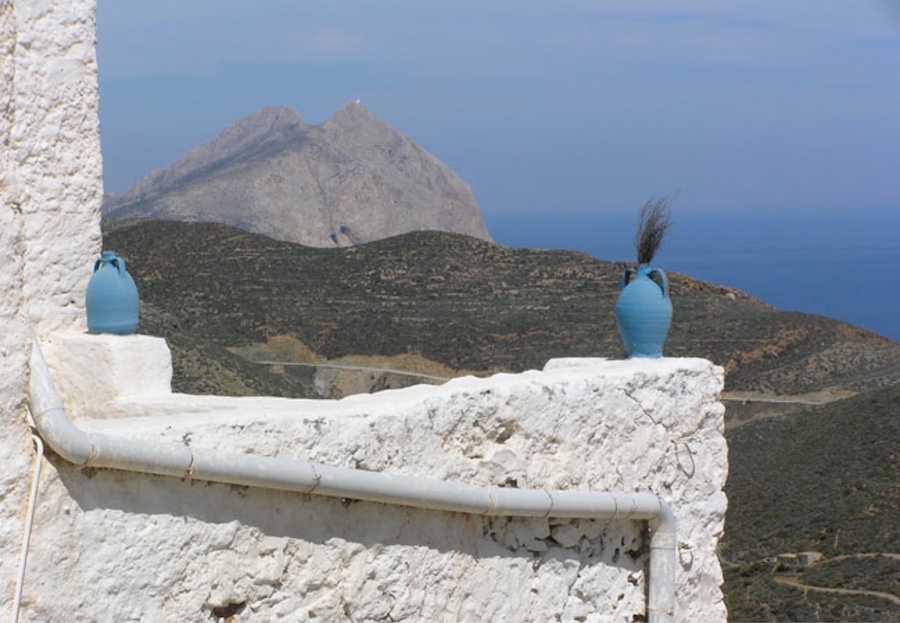
The most striking feature one sees as one sails towards the harbor is the great dark mass of Cape Kalamos on the eastern end of the island, the largest monolith (single-rock) formation in Europe, not excepting the Rock of Gibraltar or the massif of Monemvasia. It is joined to the rest of the island by a narrow, low-lying isthmus. A tiny white speck perches on the very peak, the former monastery of Kalamiotissa.
The port is a small settlement with a friendly taverna with rooms, a seasonal café and mini-market, a ticket office (open only just before a ferry is due) and—the latest innovation, installed during my 2007 visit—a cash machine (ATM)! It is a pleasant spot to sit and watch the fishermen mending their nets. Light sleepers should not stay at the port, however: there is a noisy generator located here. Just behind the latter, there begins the steep path to Klissithi beach, the first of a succession of superb beaches along the south coast. There is a pleasant enough port beach, much frequented by the locals on Sundays, with its own cliff-cave for those unable to find a room (a highly unlikely eventuality, even in August).
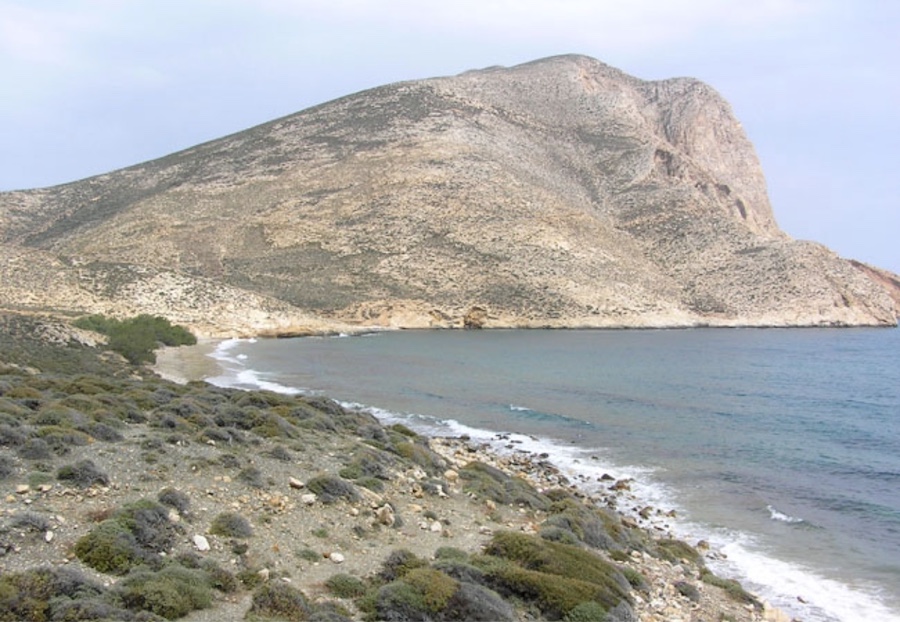
There are no hotels on the island (see Editor’s Note below), but rooms in Chora are plentiful. Proprietors in minibuses meet every ferry, as does the island bus. Visitors are driven up to Chora, gleaming white on its conical hill, its barrel-roofed houses (also found on Santorini) with their large, distinctive outdoor bake-ovens. Strenuous traditionalists may take the half-hour walk up the old mule-path (now, alas, concreted over). I can recommend the Panorama rooms (presided over by cheerful and friendly Margareta), which are clean, cheap and well-furnished, with stunning views over Anafi’s three guardian islets, Paxia, Makria and Ftena. Margareta also rents cars and motor-cycles.
Anafi has some of the best beaches in the Aegean, strung out in a series of pretty coves along the south-east coast. All except one, Katsouni, forbid camping and nudism (or Nudismis, as described on one sign). Katsouni has fine sand, and shelves gently into a pebble-free seabed, though there is little shade and that is usually occupied by campers. Much middle-aged, mahogany-colored flesh is on view—mainly German—presided over by Christian, a graying, hirsute, eccentric camper who makes the average bleach-bearded hippy look like David Niven: think Victorian novelist, only more so. You can recognize him by his cloak—covered with celestial symbols—and his palm-staff. There is a mysterious square marble pillar at one end of the beach. The atmosphere is pleasant and relaxed. It is said that a policeman once used to hide behind bushes to arrest female nudists, but there has been no sign of him lately.
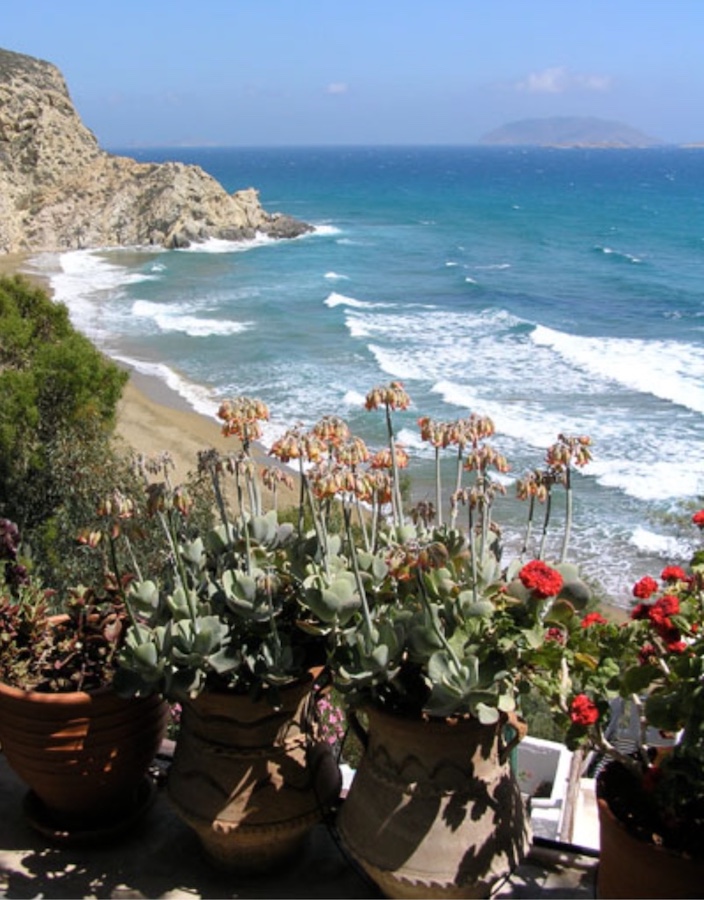
The main beach nearest Aghios Nikolaos is Klissidi. The 11:00 a.m. bus to the port drops people off near the Villa Apollon and Margarita’s appealing cafe above the beach. On the other side of Katsouni is Roukounas, said to be the best beach on the island, a long strand protected by tamarisk trees. There is an excellent seasonal taverna on the path up from the beach. The 11:30 bus from Chora to Cape Kalamos stops above the beach. These beaches are all accessible by paths from the port. Strong shoes and long trousers are recommended. Tiny green lizards will scurry away at your approach. (There are no snakes on Anafi. The Ancient Greek for “without snakes” is one of two suggested derivations for the island’s name.)
Beyond Roukounas, the determined hiker will find further isolated bays, deserted other than at the height of the season. It is possible to walk along coast paths all the way from the port to the cape, but it is not recommended unless you have stout boots, a walking stick and, above all, a very good head for heights. The only person I saw on the path was an old man on a mule, tending his goats. The track goes through a private estate, complete with swimming pool and the best-preserved windmill on the island.
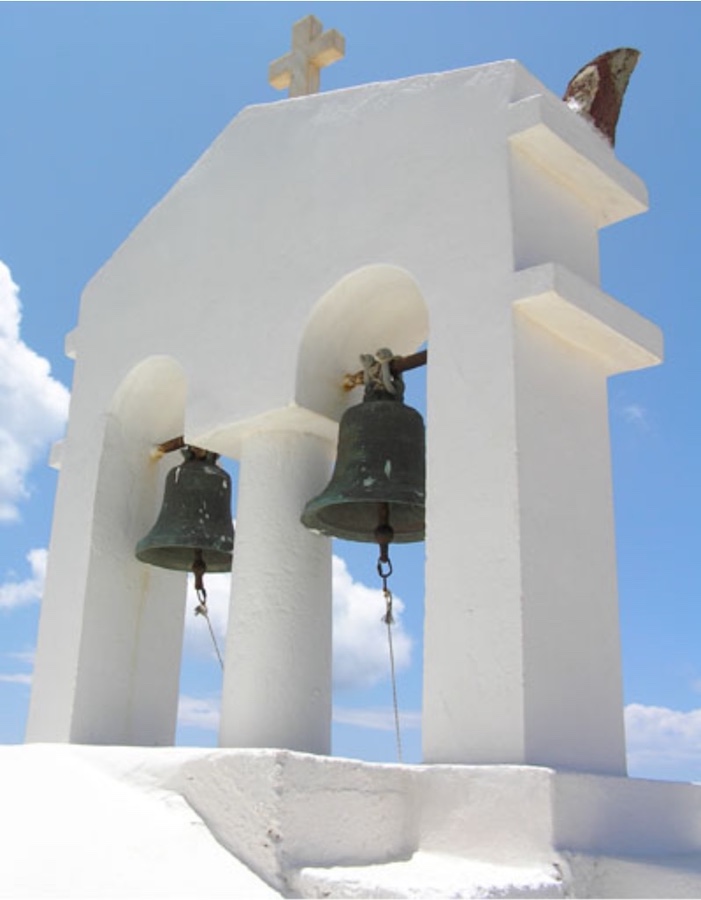
Back in Chora, the visitor will find two mini-markets, a greengrocer, a bakery, a post office, a souvenir shop, and several tavernes, cafés and bars. A major plus is the medical center, located at the western end of the village, below the square with the war memorial. It is open at 9 a.m. on weekdays and is staffed by a doctor who speaks excellent English and may be seen without an appointment! (Incidentally, the ruined windmill in the square is a great place to watch the sun go down over Ios.) Tazia Kororou’s souvenir shop doubles as an information center, and has a small library of paperbacks to borrow and return, the only books available on the island. Most shops have notices in English giving ferry and bus timetables and the opening hours of the small archaeological collection above the main church (Wednesdays and Fridays, 9 to 2.) Recommended is the taverna To Steki (“The Hangout”), the oldest taverna on the island: not necessarily the best, but I like it.
For sightseers, there are two major sites: the two monasteries at Cape Kalamos, and the ancient capital on the hill of Kastelli, where the first Anafiotes settled nearly three thousand years ago and where the medieval Frankish overlords built their fortress. At Kalamos are two monasteries: the original, Kalamiotissa, built on the summit of the cape, and the “new” monastery built on the isthmus, Zoodohou Pighis (“Life-giving Spring”)—both now monkless. The older monastery, dating from about 1600, is a stiff 1 1/2-hour climb above its successor. It is locked and there is little to see other than stunning views from 1400 feet above sea-level. This lonely spot only comes alive on 7 September, when a major religious festival takes place.
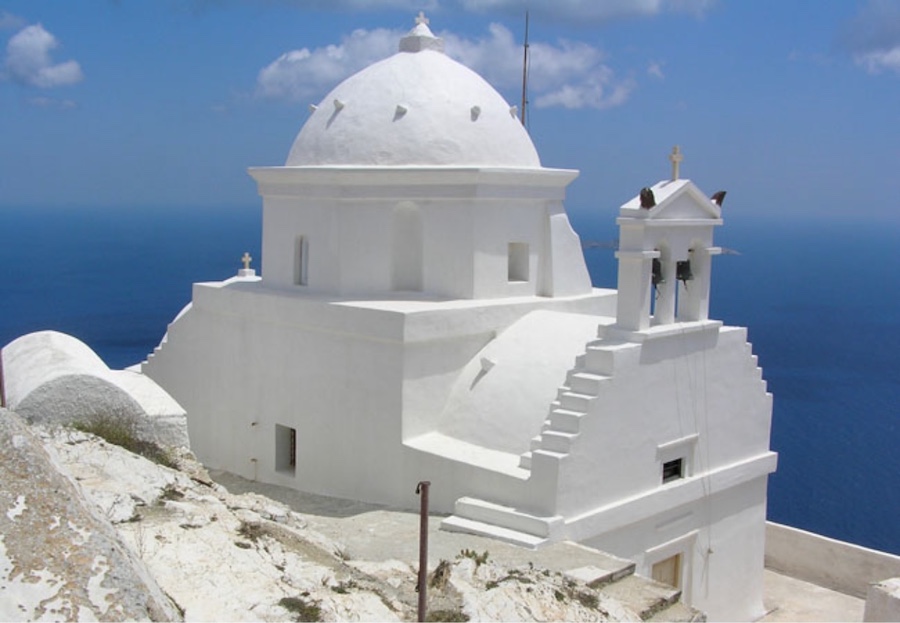
The isthmus is the site of temples built after the god Apollo supposedly saved Jason and his fleece-hunters from a watery grave by raising up Anafi out of the stormy sea. Hence an alternative version of how the island got its name (anaphe=“appeared”). The extensive remains of a temple to Apollo Aeglites were in the 18th century incorporated into the newer monastery. The front entrance, some of the side walls and a storage area have walls comprising huge dressed marble blocks from the temple. There may also have been temples to Aphrodite and Aesculapius according to inscriptions seen by Bent, but the narrow tongue of land on which they stood has never been properly excavated.
There were three monks at the “new” monastery when Bent visited in 1884. There are now none. The sole inhabitant—apart from his dog and his many friendly cats, eager to share your lunch—is the caretaker, Vassilis, a charming ex-Athenian journalist who speaks good English and will happily show visitors the church and the monastery treasures. He is one of those Greek latter-day hippie-philosophers who combine idealism and cynicism in equal measure. The monastery is the site of a major religious festival, celebrated 11 days after Easter. As an added bonus, there is a lovely shady beach 20 minutes’ walk below the monastery, past a clutch of blue beehives and a forest of oleanders. It has beautiful colored pebbles and lots of shady tamarisks. At the far end, a path leads up past a ruined building with a remarkable keystone arch of large pebbles, to a chapel-topped promontory with charming but inaccessible beaches on either side.
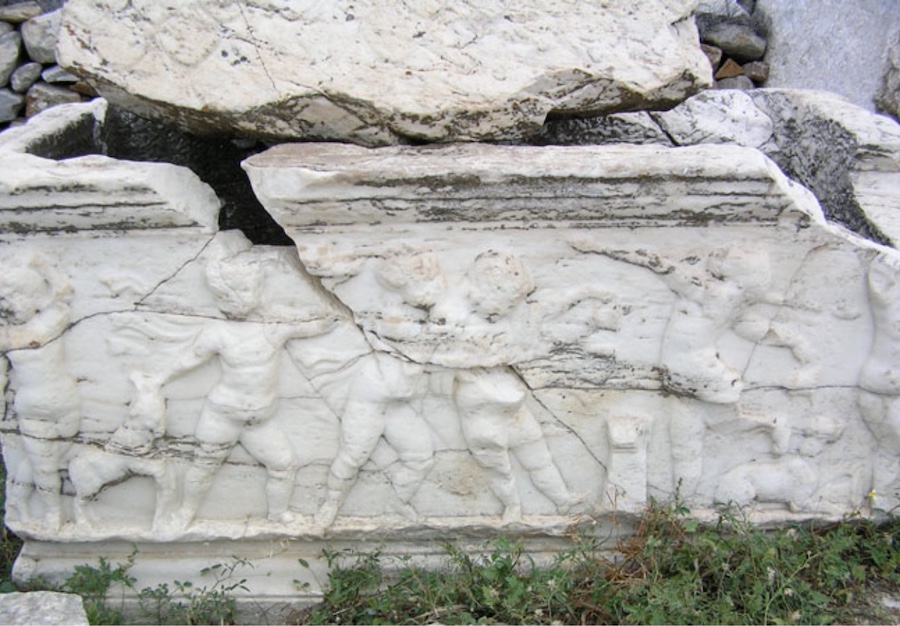
The island’s other major site is at Kastelli, supposedly settled by the Dorians in the 9th century BCE. The path is clearly signposted on the road from Chora to the cape. There are three levels. The first (20 minutes’ climb) takes the visitor to a small chapel with ruined houses around it and a threshing floor. The chief attraction here is a superb Hellenistic or Roman marble sarcophagus, beautifully carved on all four panels. The front panel shows inebriated-looking children making tributes at the altar of Bacchus. The rear panel depicts Bucephalos and Pegasus. The side panels seems to show sphinxes or griffons. Bent says he saw bits of a second sarcophagus built into house walls, but I saw no sign of this. The headless statues Bent mentioned are now in the little museum in Chora.
Another stiff climb ends at the Venetian citadel. Like all the Cycladic islands, Anafi after AD 1207 fell under the control of Frankish warlords, successively the Foscoli, the Gozzadini, the Crispi, and the Posani. William Crispi, later Duke of Naxos, built the citadel in the 15th century. There is little left to see now except extensive curtain walls. The island fell to the Turkish corsair Barbarossa in 1537. Under the Turks, the Anafiotes were left alone, so long as they paid their annual tribute to the Kapitan Pasha on Paros. The Russians briefly occupied the island during an abortive revolution Prince Orloff fomented in 1770-75, during which it is said many antiquities were taken off to St. Petersburg. The Turks regained control until the War of Independence in 1821, when Anafi sent two boatloads of men to fight the Turks and the Egyptians.
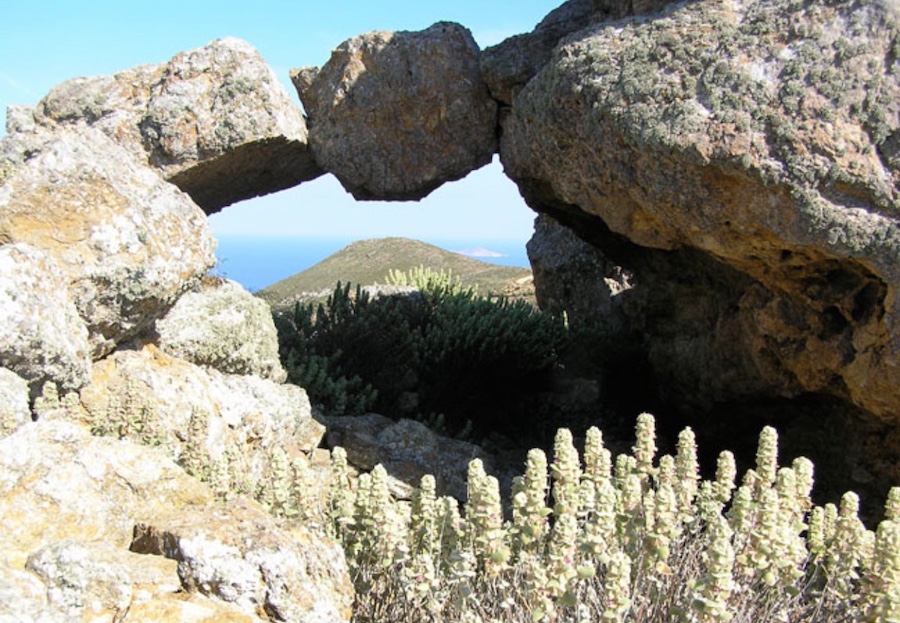
Bent was impressed with the site: “. . . from the remains we saw it appears to have once been a very strong rich city, among the finest in the Cyclades.” He wrote of “colossal walls,” but they seem to have fallen down in the 120 years since he was there. It is clear from the ruins that there were colossal walls, but there is little to see now apart from the views and a fine round marble lipped font, the only artefact I could see. A final 15-minute pathless scramble takes one to the very top of the mountain, at about a thousand feet. At the top there are three large cairns, a curtain wall, and stunning views. Unfortunately, the old archaeologists’ saying, “Where there’s a wall, there’s a way,” doesn’t apply here: not worth a detour.
Ten years ago (c. 2000, at this writing), the island did not boast a single road. Now there are roads from Chora to the west, north, and east coasts. There are tiny settlements on the way, but not big enough, one would think, to merit macadam roads that are used perhaps two or three times a day. They do, however, provide a destination for those hiring cars and motorcycles in Chora. One suspects that is why they were built, of course. Unhappily, road-building means the destruction of ancient kalderimini or mule paths. However enough paths survive to make the island a joy for walkers.
The size of the island (38 sq. kilometers) means that it is almost impossible to get lost on Anafi. Most of the many chapels are unlocked, providing some relief from the sun in summer. There is a small beach on the west side of the island (Prasses) of shale and large pebbles, isolated enough for the most determined recluse. It is a two-hour walk and passes through two hamlets, Kamessi and Vagia. Below the hamlets are fertile valleys with well-tended plots of land, where most of the island’s produce is presumably grown. There are other beaches en route, but it hardly seems worth the effort, unless one has wheels. Walkers will be pleased to know that vehicle use is almost entirely restricted to between Chora and Aghios Nikolaos port: they will have the rest of the island to themselves.
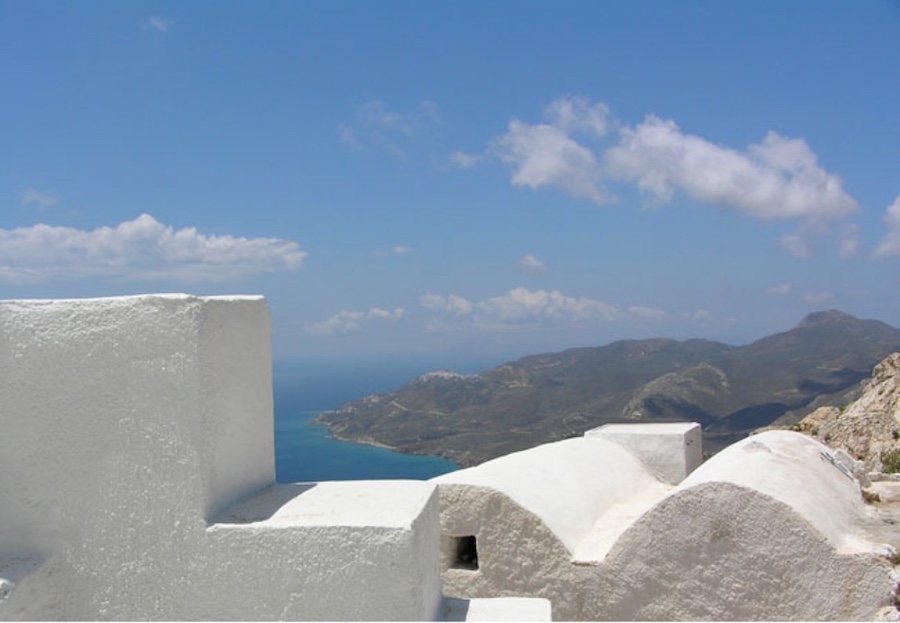
A fascinating study of Anafi in the years before the advent of tourism was made by Dr. Margaret Kenna, professor of Anthropology at the University of Wales. In the 1960s, the island was the subject of her doctorial thesis on inheritance, dowry, and ritual in the lives of the islanders. In the 1970s, she studied migration from Anafi and, in the 1980s, the impact of the beginnings of tourism. Life on a small Greek island in the 1960s was no holiday. Kenna walked everywhere over crude mule tracks. She pulled up water from a deep cistern. She baked bread in an outdoor oven, heated by burning thorn bushes gathered by hand. In the evenings, she typed by the light of a paraffin lamp (no electricity till 1974.) She was sunburned in summer, suffered chilblains in winter, and was bitten by fleas all the year round. When she wore trousers to keep out the cold, the village was scandalized.
In 1988, Dr. Kenna was invited into a family home to view curios. What she found was over 160 glass and celluloid negatives dating from between 1935 and 1941, documenting the lives of the political exiles. The images had been hidden behind a false wall in a rented house. When the exiles were taken to Athens during the Italian occupation, the archive was forgotten, until children, playing in an abandoned house, found it, together with minute books and other political memorabilia. The archive, which can be accessed on the internet, is probably the most complete record of life on a small Greek island during the period. People are shown bathing and picnicking. Festivals, weddings, and funerals are depicted. Visitors to Anafi today will note familiar landmarks.
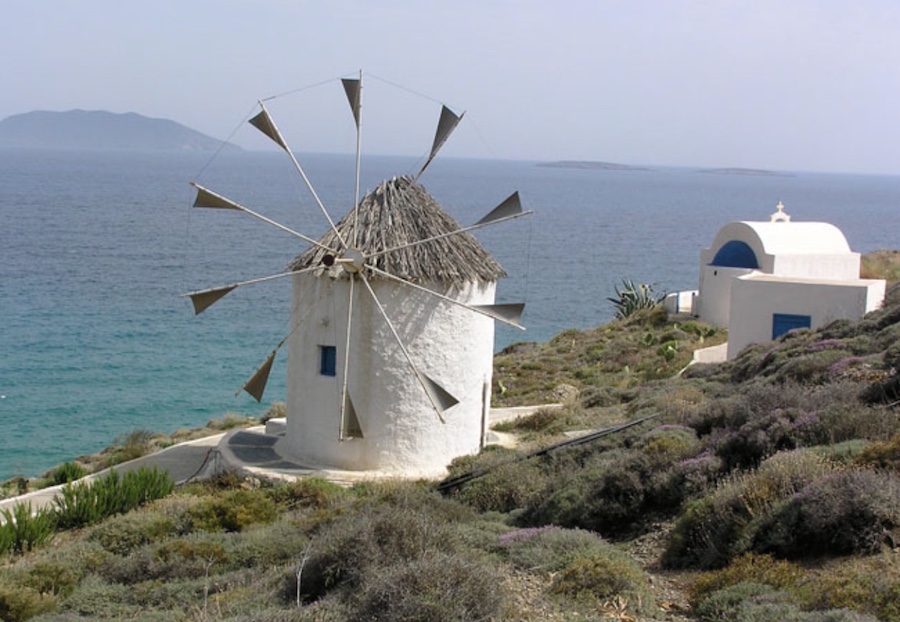
So, why Anafi? Here are some of the things a visitor will not encounter: hotels; package tourists; discos; English pubs; English food; newspapers; harassing taverna waiters; kamakia (young predatory Greek males); people throwing up; rude or bored locals; day trippers; crowds of any sort. Here is what will be encountered, for the foreseeable future: peace and quiet; intelligent visitors; stars; goat bells; donkeys; courtesy and friendliness; glorious beaches; superb food; wild flowers and herbs; mule paths; breathtaking views; sunsets. Convinced?
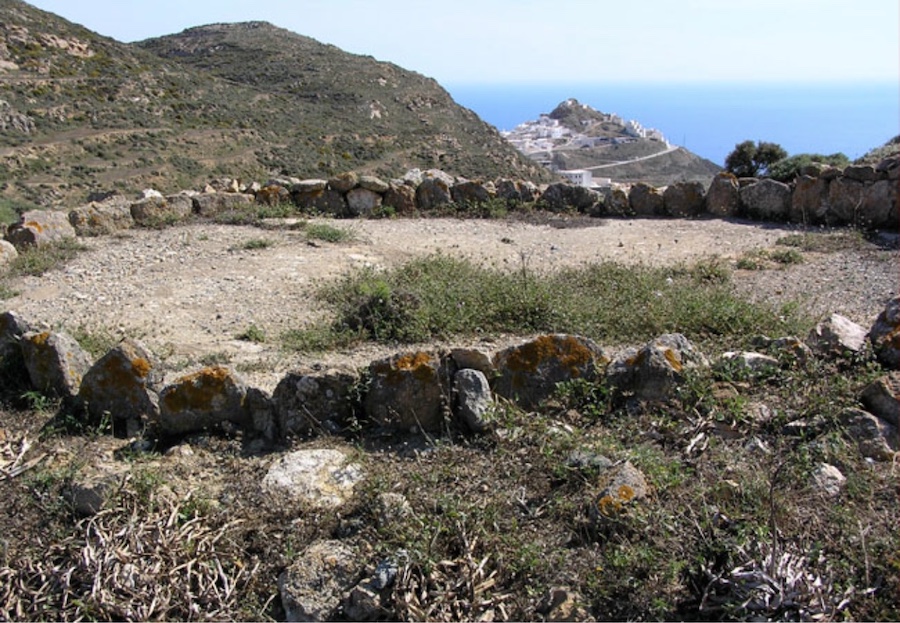
![]()
Editor’s Note: House’s essay was written in 2007. Matt Barrett, another “Hubris” Contributor, has a guide dating from 2012.
Further reading:
James Theodore Bent: The Cyclades: Life Among the Insular Greeks. 1884. Reprinted in 2002 by Archaeopress of Oxford.
Mrs. J. T. Bent: World Enough and Time. Travel Chronicles of Mrs. J. T. Bent. Archaeopress print-on-demand book.

